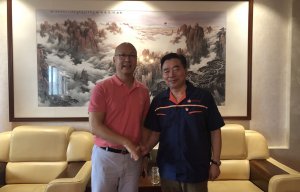
Largest-ever order for Oerlikon Neumag
Oerlikon will be showing chemical fibre applications made of polyester and polypropylene and what they can do in these fields at the upcoming Techtextil.

29th April 2019
Innovation in Textiles
|
Remscheid
Oerlikon Manmade Fibers segment and its brands Oerlikon Barmag, Oerlikon Neumag and Oerlikon Nonwoven offer technologies that lay the foundation for many applications. © Oerlikon
Oerlikon will be showing chemical fibre applications made of polyester and polypropylene and what they can do in these fields at the upcoming Techtextil in Frankfurt next month. “However, these exhibits are only a communicative means to an end, as Oerlikon is primarily interested in placing the associated machinery and plant solutions at the centre of discussions with trade fair visitors,” the company explains.
More than two thirds of all technical innovations are directly or indirectly based on new materials, according to the German Research Ministry. For decades, Oerlikon Barmag has been offering special solutions for the production of so-called industrial yarns (IDY) that are tailored to customers worldwide. “We will once again be presenting numerous innovations at this trade fair to inspire our customers,” explained Dr-Ing Dipl-Chem Roy Dolmans, Technology Manager IDY and R&D Filament Processing.
Everyday textile products also meet high demands, as the manufacture of car safety belts shows. In the automotive world, chemical fibres have become indispensable: the German Textile Research Board says that every car drives with around 30 kg of textiles. They are found in airbags, car roofs, upholstery, trim, switches, operating elements, drive belts or hoses.
“The automotive industry is also interested in low costs when it comes to their use. A prime example of the economic production of technical textiles in the automotive sector is the manufacture of tire cord from HMLS (High Modulus Low Shrinkage) yarns. These precursors made of polyester are extremely tear-resistant, still highly elastic as well as temperature and dimensionally stable,” explained Dr Dolmans. The topic of traceability along the entire textile value chain plays also a major role, especially in the automotive industry. “Thanks to our production and process solutions for our customers and our own DIN ISO certifications, we at Oerlikon can guarantee traceability in the production process at any time.”
Twisted into a flat fabric, the industrial yarns lie between several rubber layers and stabilise the car tires on the road. Talking of roadways, technical yarns are also at work underneath. Geotextiles secure and stabilise the soil in road and path construction. The flexible surface structures made of PET fibres, for example, are extremely tough, creep-resistant and can survive underground for decades.
Textiles have long since arrived in the construction sector and are increasingly playing a role as the "fifth building material" alongside steel, concrete, wood and glass. Building materials of the future are also nonwovens. The nonwoven, textile fabrics can be equipped with a variety of properties on the basis of various manufacturing processes and combination techniques. They are temperature- and shock-resistant, breathable and at the same time resistant to moisture, mould and detachment, and are used for roofing, insulation, insulation and drainage throughout the construction sector. Oerlikon Nonwoven offers the corresponding machine and system solutions.
In medicine too, nonwovens are experiencing a real boom as an inexpensive material for surgical gowns or bandages, because they function as a liquid or bacterial barrier, but remain vapour-permeable and absorbent and do not stick together. The range of applications extends from filtration, baby diapers, wipes and napkins to geotextiles and felt carpets.
For the large variety of textile floor coverings, special textured continuous filament yarn made of polypropylene or polyester is particularly suitable: Oerlikon Neumag stands for this as the expert for machine and plant solutions for the production of BCF yarns with a wide variety of properties.
Functional clothing textiles are a playground for innovative applications of technical yarns. The spectrum of new developments ranges from breathable tracksuits with living microbial cells that react to moisture fluctuations to smart clothing that uses electronics and sensors to open up previously unknown functions. Smart textiles can generate heat, light and electricity, measure temperature and vital functions, heal wounds and reduce pain, modernize industries and make cars and construction safer or more comfortable.
Given this future scenario, it is no wonder that technical textiles, the materials of tomorrow, are on the upswing worldwide. Analysts such as the London market researchers of Future Market Insights estimate that the world market volume for technical textiles will climb from around US$ 166 billion in 2016 to a good US$ 260 billion in 2027. This upswing will certainly also drive the market for polyester fibres, which has been growing continuously for many years.
Oerlikon Manmade Fibers segment and its brands Oerlikon Barmag, Oerlikon Neumag and Oerlikon Nonwoven offer technologies from melt to yarn, fibres and nonwovens that lay the foundation for many applications.

Business intelligence for the fibre, textiles and apparel industries: technologies, innovations, markets, investments, trade policy, sourcing, strategy...
Find out more